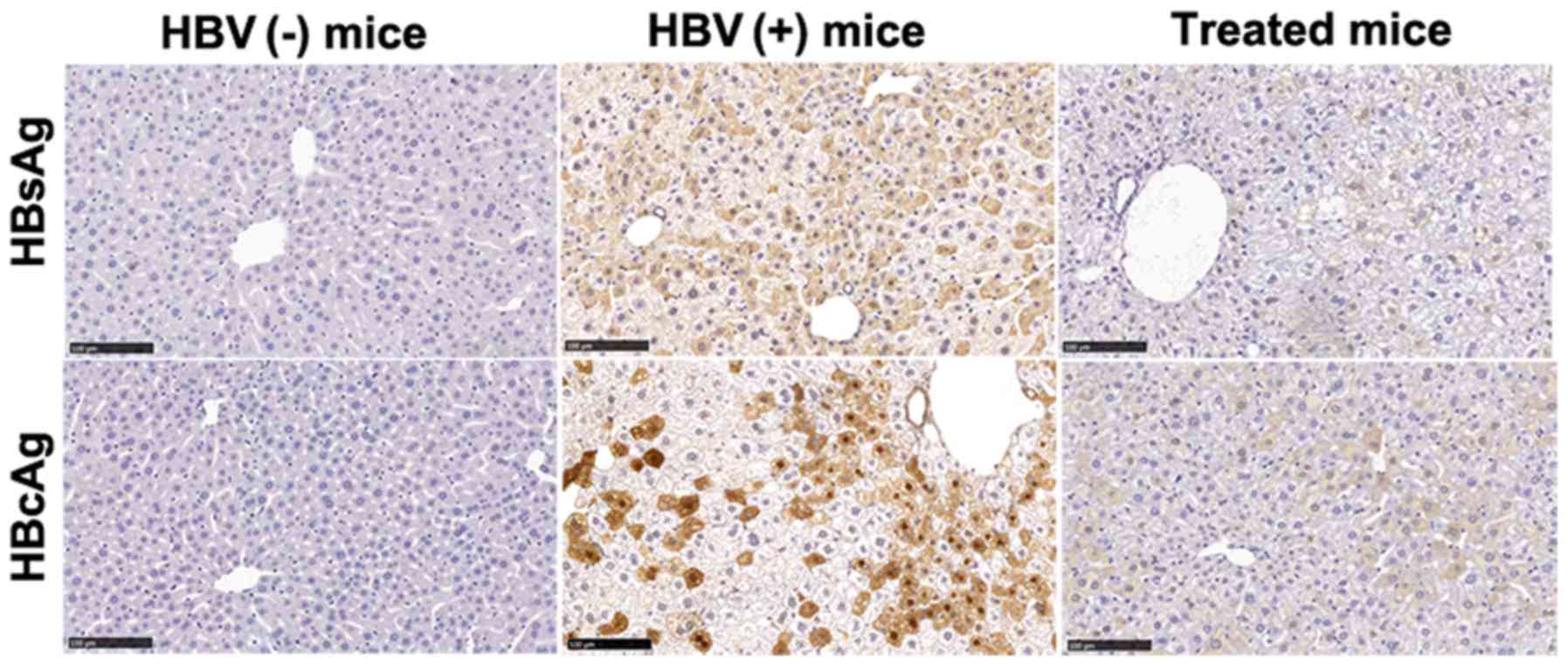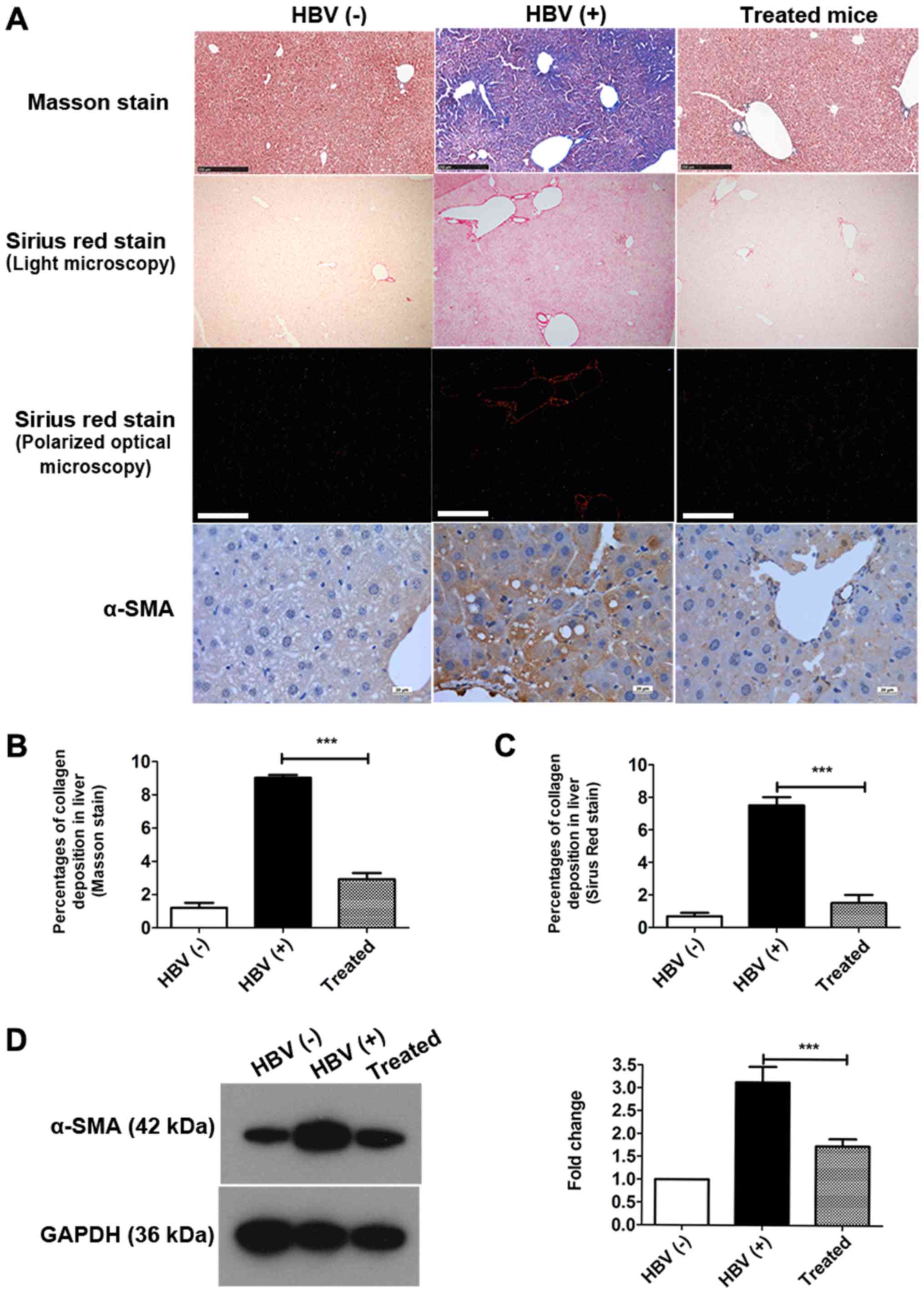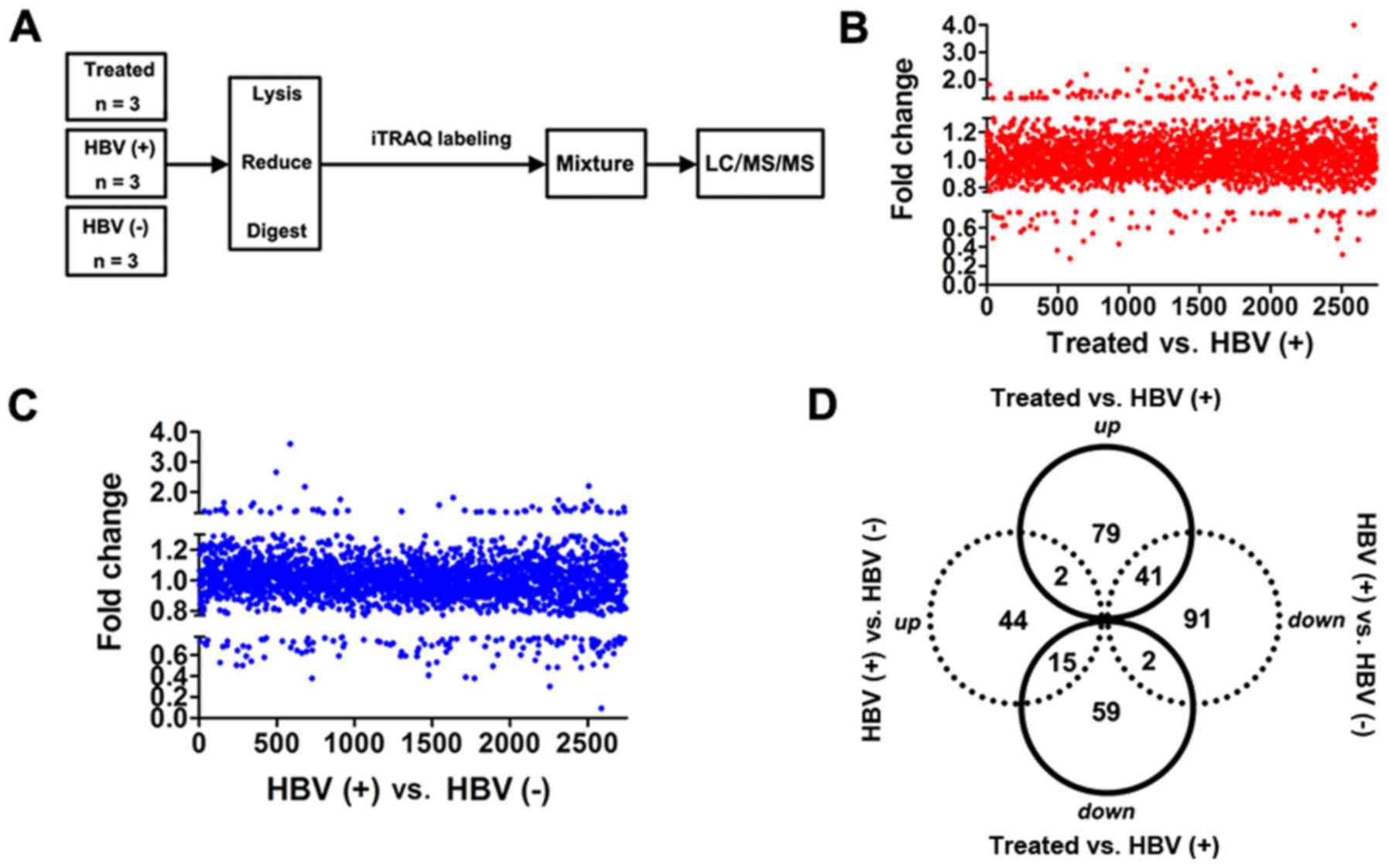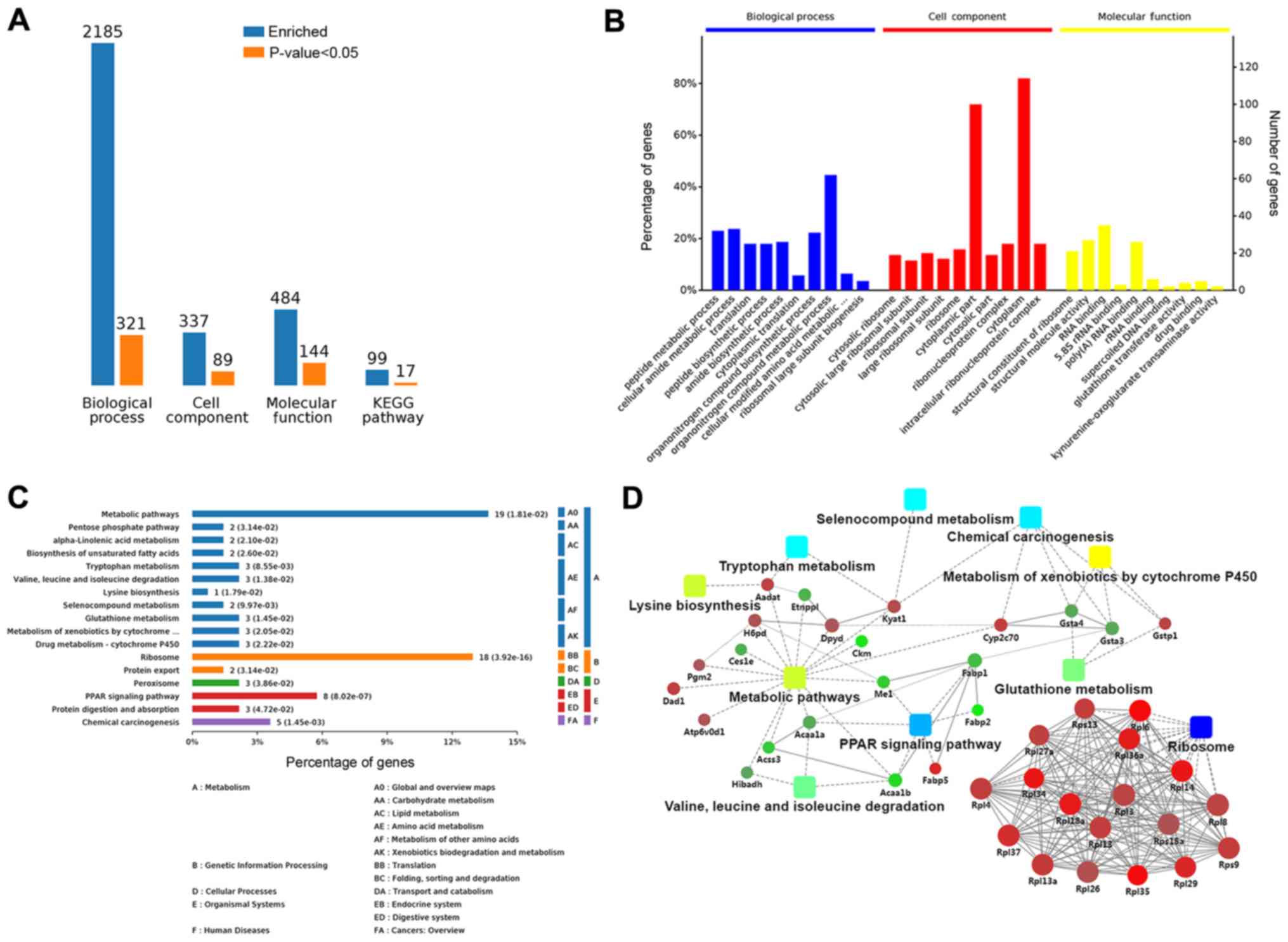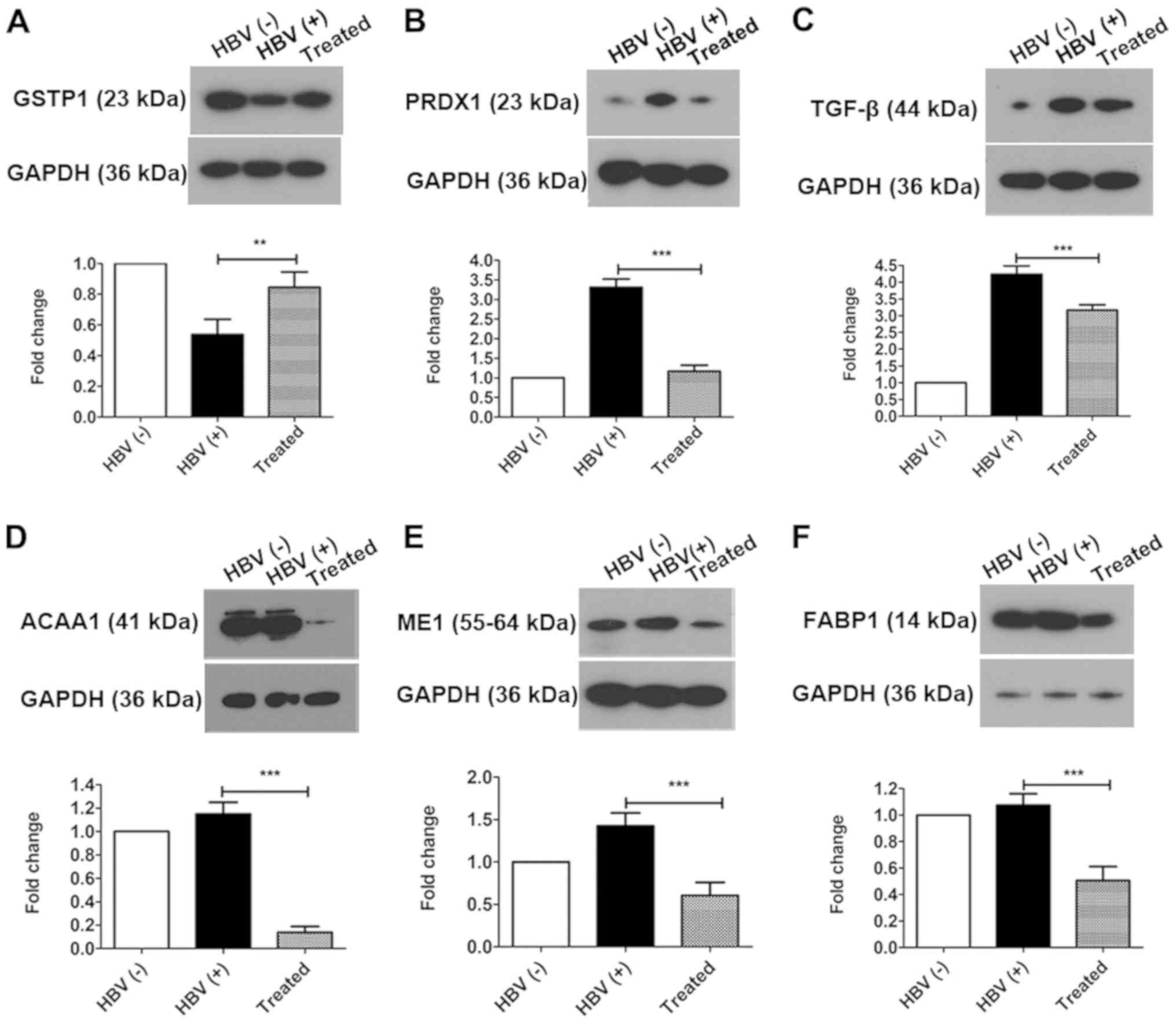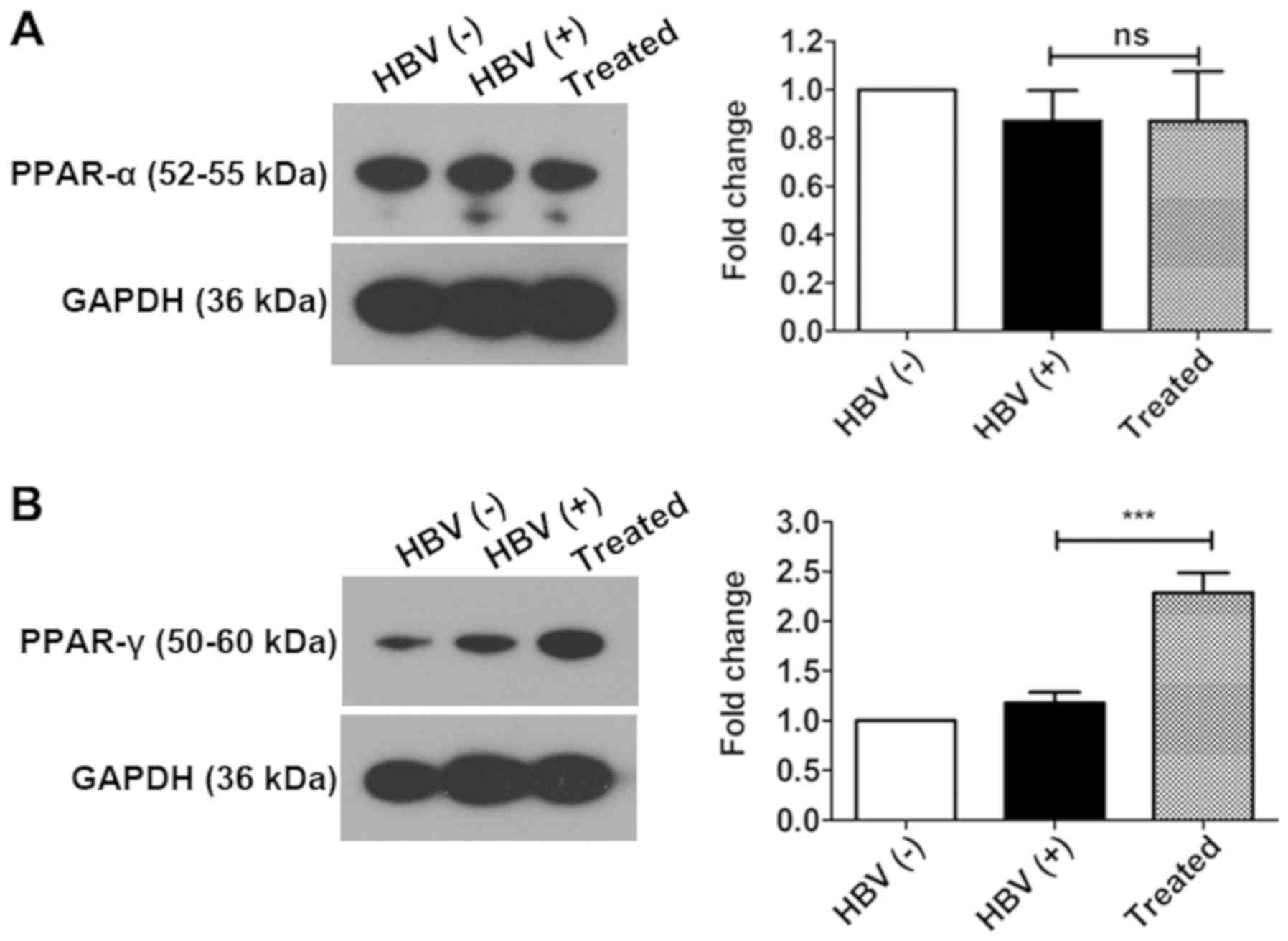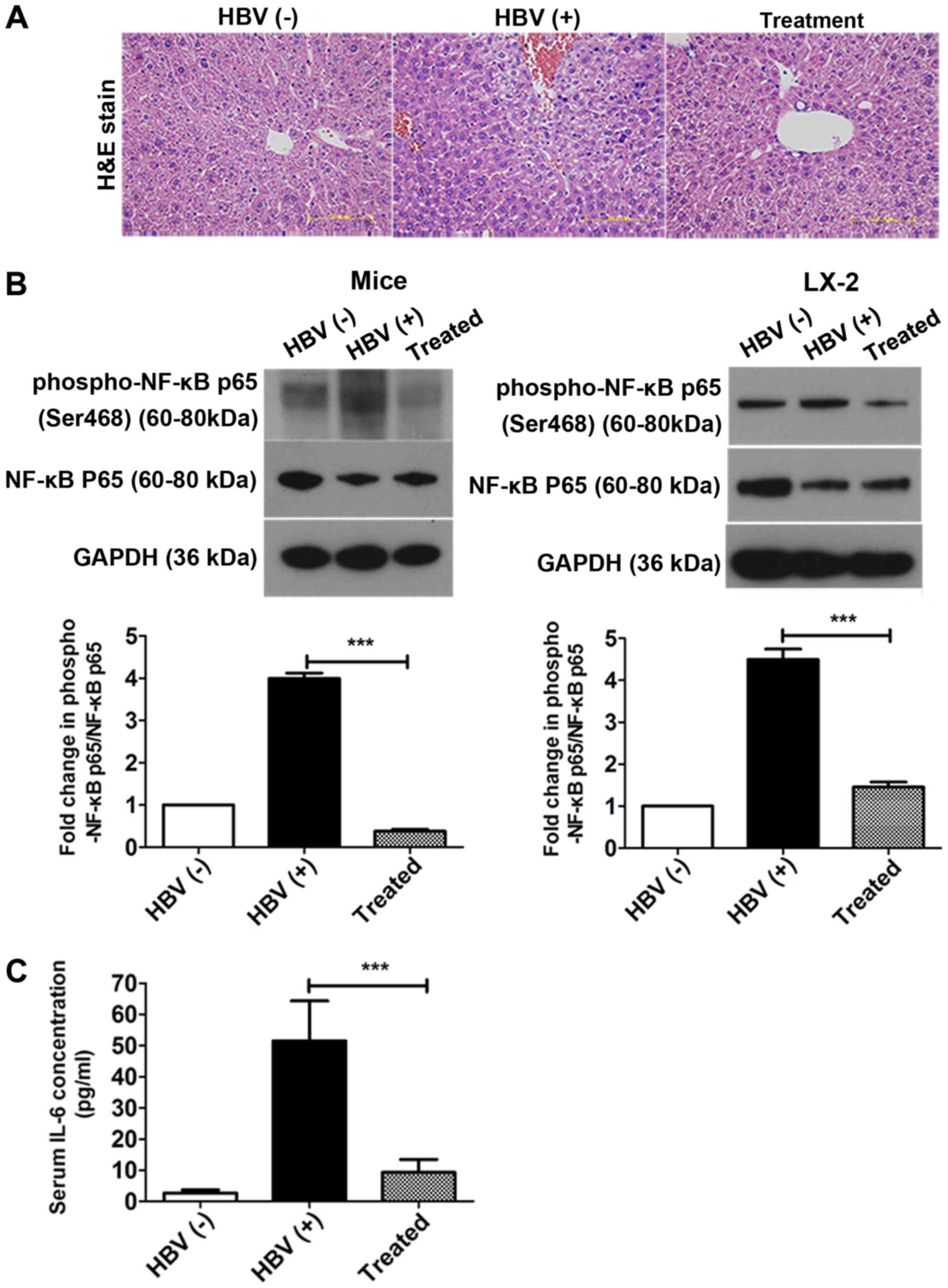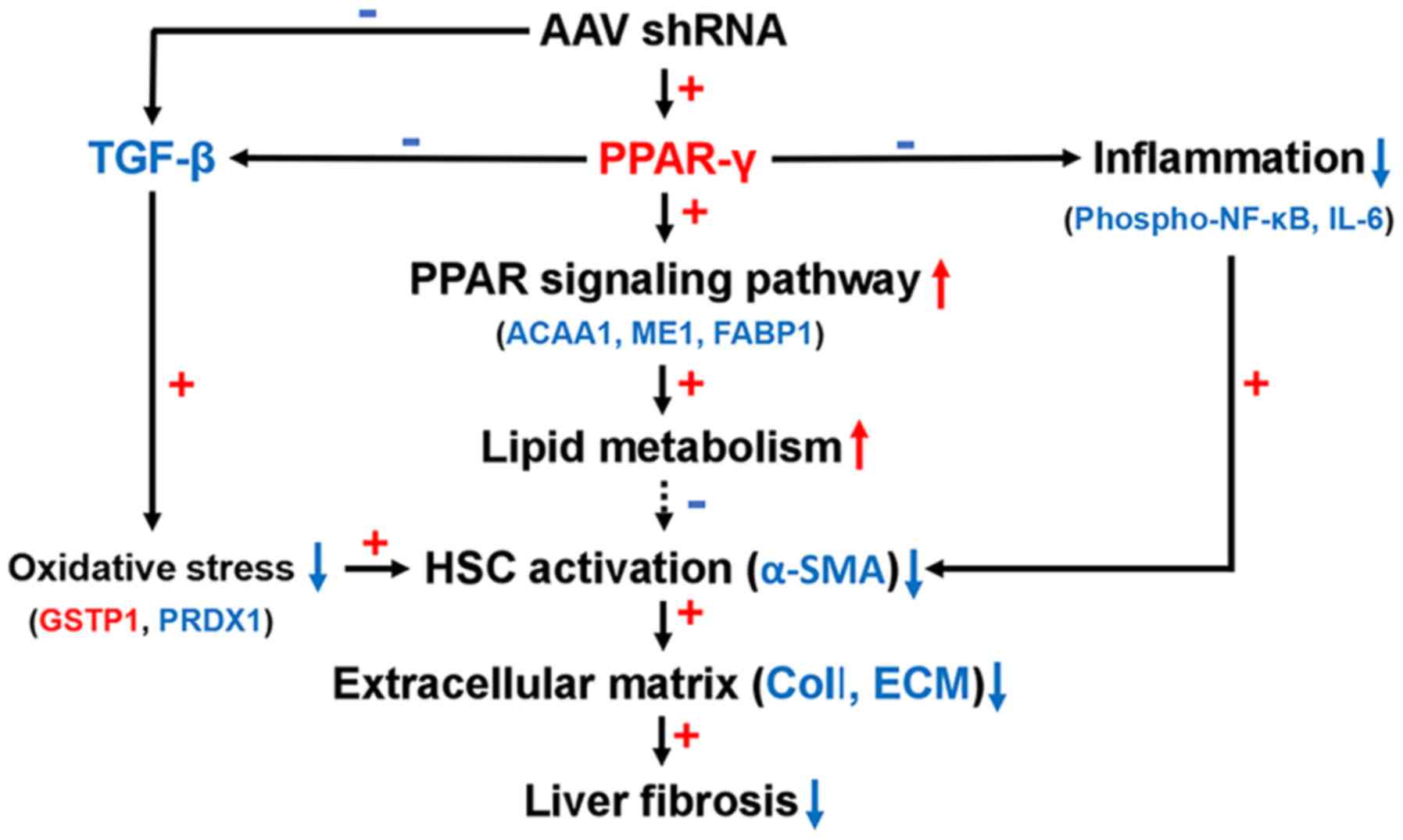|
1
|
Ringelhan M, Heikenwalder M and Protzer U:
Direct effects of hepatitis B virus-encoded proteins and chronic
infection in liver cancer development. Dig Dis. 31:138–151. 2013.
View Article : Google Scholar : PubMed/NCBI
|
|
2
|
McMahon BJ: The natural history of chronic
hepatitis B virus infection. Hepatology. 49(5 Suppl): S45–S55.
2009. View Article : Google Scholar : PubMed/NCBI
|
|
3
|
Lin CL and Kao JH: Risk stratification for
hepatitis B virus related hepatocellular carcinoma. J Gastroenterol
Hepatol. 28:10–17. 2013. View Article : Google Scholar
|
|
4
|
Bonilla Guerrero R and Roberts LR: The
role of hepatitis B virus integrations in the pathogenesis of human
hepatocellular carcinoma. J Hepatol. 42:760–777. 2005. View Article : Google Scholar : PubMed/NCBI
|
|
5
|
Karayiannis P: Hepatitis B virus:
Virology, molecular biology, life cycle and intrahepatic spread.
Hepatol Int. 11:500–508. 2017. View Article : Google Scholar : PubMed/NCBI
|
|
6
|
Poynard T, Mathurin P, Lai CL, Guyader D,
Poupon R, Tainturier MH, Myers RP, Muntenau M, Ratziu V, Manns M,
et al: A comparison of fibrosis progression in chronic liver
diseases. J Hepatol. 38:257–265. 2003. View Article : Google Scholar : PubMed/NCBI
|
|
7
|
Hernandez-Gea V and Friedman SL:
Pathogenesis of liver fibrosis. Annu Rev Pathol. 6:425–456. 2011.
View Article : Google Scholar
|
|
8
|
Alkofer B, Lepennec V and Chiche L:
Hepatocellular cancer in the non-cirrhotic liver. J Visc Surg.
148:3–11. 2011. View Article : Google Scholar : PubMed/NCBI
|
|
9
|
Friedman SL: Mechanisms of hepatic
fibrogenesis. Gastroenterology. 134:1655–1669. 2008. View Article : Google Scholar : PubMed/NCBI
|
|
10
|
Friedman SL, Roll FJ, Boyles J and Bissell
DM: Hepatic lipocytes: The principal collagen-producing cells of
normal rat liver. Proc Natl Acad Sci USA. 82:8681–8685. 1985.
View Article : Google Scholar : PubMed/NCBI
|
|
11
|
Senoo H, Mezaki Y and Fujiwara M: The
stellate cell system (vitamin A-storing cell system). Anat Sci Int.
92:387–455. 2017. View Article : Google Scholar : PubMed/NCBI
|
|
12
|
Popov Y and Schuppan D: Targeting liver
fibrosis: Strategies for development and validation of antifibrotic
therapies. Hepatology. 50:1294–1306. 2009. View Article : Google Scholar : PubMed/NCBI
|
|
13
|
Gressner AM, Weiskirchen R, Breitkopf K
and Dooley S: Roles of TGF-beta in hepatic fibrosis. Front Biosci.
7:d793–d807. 2002. View
Article : Google Scholar : PubMed/NCBI
|
|
14
|
Rahimi RA and Leof EB: TGF-beta signaling:
A tale of two responses. J Cell Biochem. 102:593–608. 2007.
View Article : Google Scholar : PubMed/NCBI
|
|
15
|
Shek FW and Benyon RC: How can
transforming growth factor beta be targeted usefully to combat
liver fibrosis? Eur J Gastroenterol Hepatol. 16:123–126. 2004.
View Article : Google Scholar : PubMed/NCBI
|
|
16
|
Weidinger A and Kozlov AV: Biological
activities of reactive oxygen and nitrogen species: Oxidative
stress versus signal transduction. Biomolecules. 5:472–484. 2015.
View Article : Google Scholar : PubMed/NCBI
|
|
17
|
Kim YM and Cho M: Activation of NADPH
oxidase subunit NCF4 induces ROS-mediated EMT signaling in HeLa
cells. Cell Signal. 26:784–796. 2014. View Article : Google Scholar : PubMed/NCBI
|
|
18
|
Schafer FQ and Buettner GR: Redox
environment of the cell as viewed through the redox state of the
glutathione disulfide/glutathione couple. Free Radic Biol Med.
30:1191–1212. 2001. View Article : Google Scholar : PubMed/NCBI
|
|
19
|
Dayer R, Fischer BB, Eggen RI and Lemaire
SD: The peroxiredoxin and glutathione peroxidase families in
Chlamydomonas reinhardtii. Genetics. 179:41–57. 2008. View Article : Google Scholar : PubMed/NCBI
|
|
20
|
Wheeler MD, Kono H, Yin M, Nakagami M,
Uesugi T, Arteel GE, Gäbele E, Rusyn I, Yamashina S, Froh M, et al:
The role of kupffer cell oxidant production in early
ethanol-induced liver disease. Free Radic Biol Med. 31:1544–1549.
2001. View Article : Google Scholar : PubMed/NCBI
|
|
21
|
Issemann I and Green S: Activation of a
member of the steroid hormone receptor superfamily by peroxisome
proliferators. Nature. 347:645–650. 1990. View Article : Google Scholar : PubMed/NCBI
|
|
22
|
Greene ME, Blumberg B, McBride OW, Yi HF,
Kronquist K, Kwan K, Hsieh L, Greene G and Nimer SD: Isolation of
the human peroxisome proliferator activated receptor gamma cDNA:
Expression in hematopoietic cells and chromosomal mapping. Gene
Expr. 4:281–299. 1995.PubMed/NCBI
|
|
23
|
Dreyer C, Krey G, Keller H, Givel F,
Helftenbein G and Wahli W: Control of the peroxisomal
beta-oxidation pathway by a novel family of nuclear hormone
receptors. Cell. 68:879–887. 1992. View Article : Google Scholar : PubMed/NCBI
|
|
24
|
Xing G, Zhang L, Zhang L, Heynen T,
Yoshikawa T, Smith M, Weiss S and Detera-Wadleigh S: Rat PPAR delta
contains a CGG triplet repeat and is prominently expressed in the
thalamic nuclei. Biochem Biophys Res Commun. 217:1015–1025. 1995.
View Article : Google Scholar : PubMed/NCBI
|
|
25
|
Chen F, Law SW and O'Malley BW:
Identification of two mPPAR related receptors and evidence for the
existence of five subfamily members. Biochem Biophys Res Commun.
196:671–677. 1993. View Article : Google Scholar : PubMed/NCBI
|
|
26
|
Xu J, Fu Y and Chen A: Activation of
peroxisome proliferator-activated receptor-gamma contributes to the
inhibitory effects of curcumin on rat hepatic stellate cell growth.
Am J Physiol Gastrointest Liver Physiol. 285:G20–G30. 2003.
View Article : Google Scholar : PubMed/NCBI
|
|
27
|
Ahmadian M, Suh JM, Hah N, Liddle C,
Atkins AR, Downes M and Evans RM: PPARγ signaling and metabolism:
The good, the bad and the future. Nat Med. 19:557–566. 2013.
View Article : Google Scholar : PubMed/NCBI
|
|
28
|
Leclercq IA, Da Silva Morais A, Schroyen
B, Van Hul N and Geerts A: Insulin resistance in hepatocytes and
sinusoidal liver cells: Mechanisms and consequences. J Hepatol.
47:142–156. 2007. View Article : Google Scholar : PubMed/NCBI
|
|
29
|
Zhao X, Xue J, Wang XL, Zhang Y, Deng M
and Xie ML: Involvement of hepatic peroxisome
proliferator-activated receptor α/γ in the therapeutic effect of
osthole on high-fat and high-sucrose-induced steatohepatitis in
rats. Int Immunopharmacol. 22:176–181. 2014. View Article : Google Scholar : PubMed/NCBI
|
|
30
|
Guo YT, Leng XS, Li T, Peng JR, Song SH,
Xiong LF and Qin ZZ: Effect of ligand of peroxisome
proliferator-activated receptor gamma on the biological characters
of hepatic stellate cells. World J Gastroenterol. 11:4735–4739.
2005. View Article : Google Scholar : PubMed/NCBI
|
|
31
|
Anty R and Lemoine M: Liver fibrogenesis
and metabolic factors. Clin Res Hepatol Gastroenterol. 35(Suppl 1):
S10–S20. 2011. View Article : Google Scholar : PubMed/NCBI
|
|
32
|
Sun K, Wang Q and Huang XH: PPAR gamma
inhibits growth of rat hepatic stellate cells and TGF beta-induced
connective tissue growth factor expression. Acta Pharmacol Sin.
27:715–723. 2006. View Article : Google Scholar : PubMed/NCBI
|
|
33
|
Yang L, Chan CC, Kwon OS, Liu S, McGhee J,
Stimpson SA, Chen LZ, Harrington WW, Symonds WT and Rockey DC:
Regulation of peroxisome proliferator-activated receptor-gamma in
liver fibrosis. Am J Physiol Gastrointest Liver Physiol.
291:G902–G911. 2006. View Article : Google Scholar : PubMed/NCBI
|
|
34
|
Brasier AR: The NF-kappaB regulatory
network. Cardiovasc Toxicol. 6:111–130. 2006. View Article : Google Scholar
|
|
35
|
Calzado MA, Bacher S and Schmitz ML:
NF-kappaB inhibitors for the treatment of inflammatory diseases and
cancer. Curr Med Chem. 14:367–376. 2007. View Article : Google Scholar : PubMed/NCBI
|
|
36
|
Luedde T and Schwabe RF: NF-κB in the
liver-linking injury, fibrosis and hepatocellular carcinoma. Nat
Rev Gastroenterol Hepatol. 8:108–118. 2011. View Article : Google Scholar : PubMed/NCBI
|
|
37
|
Kong D, Zhang F, Wei D, Zhu X, Zhang X,
Chen L, Lu Y and Zheng S: Paeonol inhibits hepatic fibrogenesis via
disrupting nuclear factor-κB pathway in activated stellate cells:
In vivo and in vitro studies. J Gastroenterol Hepatol.
28:1223–1233. 2013. View Article : Google Scholar : PubMed/NCBI
|
|
38
|
Liu M, Wu Q, Chen P, Büchele B, Bian M,
Dong S, Huang D, Ren C, Zhang Y, Hou X, et al: A boswellic
acid-containing extract ameliorates schistosomiasis liver granuloma
and fibrosis through regulating NF-κB signaling in mice. PLoS One.
9:e1001292014. View Article : Google Scholar
|
|
39
|
Bromberg J and Wang TC: Inflammation and
cancer: IL-6 and STAT3 complete the link. Cancer Cell. 15:79–80.
2009. View Article : Google Scholar : PubMed/NCBI
|
|
40
|
Naugler WE and Karin M: The wolf in
sheep's clothing: The role of interleukin-6 in immunity,
inflammation and cancer. Trends Mol Med. 14:109–119. 2008.
View Article : Google Scholar : PubMed/NCBI
|
|
41
|
Wobser H, Dorn C, Weiss TS, Amann T,
Bollheimer C, Büttner R, Schölmerich J and Hellerbrand C: Lipid
accumulation in hepato-cytes induces fibrogenic activation of
hepatic stellate cells. Cell Res. 19:996–1005. 2009. View Article : Google Scholar : PubMed/NCBI
|
|
42
|
Montiel-Duarte C, Ansorena E,
López-Zabalza MJ, Cenarruzabeitia E and Iraburu MJ: Role of
reactive oxygen species, glutathione and NF-kappaB in apoptosis
induced by 3,4-methylenedioxymethamphetamine ('Ecstasy') on hepatic
stellate cells. Biochem Pharmacol. 67:1025–1033. 2004. View Article : Google Scholar : PubMed/NCBI
|
|
43
|
Hernández E, Bucio L, Souza V, Escobar MC,
Gómez-Quiroz LE, Farfán B, Kershenobich D and Gutiérrez-Ruiz MC:
Pentoxifylline downregulates alpha (I) collagen expression by the
inhibition of Ikappabalpha degradation in liver stellate cells.
Cell Biol Toxicol. 24:303–314. 2008. View Article : Google Scholar
|
|
44
|
Ye L, Kan F, Yan T, Cao J, Zhang L, Wu Z
and Li W: Enhanced antiviral and antifibrotic effects of short
hairpin RNAs targeting HBV and TGF-β in HBV-persistent mice. Sci
Rep. 7:38602017. View Article : Google Scholar
|
|
45
|
Kan F, Ye L, Yan T, Cao J, Zheng J and Li
W: Proteomic and transcriptomic studies of HBV-associated liver
fibrosis of an AAV-HBV-infected mouse model. BMC Genomics.
18:6412017. View Article : Google Scholar : PubMed/NCBI
|
|
46
|
The Gene Ontology Consortium: The gene
ontology resource: 20 Years and still GOing strong. Nucleic Acids
Res. 47(D1): D330–D338. 2019. View Article : Google Scholar
|
|
47
|
Kanehisa M, Sato Y, Furumichi M, Morishima
K and Tanabe M: New approach for understanding genome variations in
KEGG. Nucleic Acids Res. 47(D1): D590–D595. 2019. View Article : Google Scholar :
|
|
48
|
Dillon ST, Bhasin MK, Feng X, Koh DW and
Daoud SS: Quantitative proteomic analysis in HCV-induced HCC
reveals sets of proteins with potential significance for racial
disparity. J Transl Med. 11:2392013. View Article : Google Scholar : PubMed/NCBI
|
|
49
|
Kanehisa M and Goto S: KEGG: Kyoto
encyclopedia of genes and genomes. Nucleic Acids Res. 28:27–30.
2000. View Article : Google Scholar
|
|
50
|
Yin L, Qi Y, Xu Y, Xu L, Han X, Tao X,
Song S and Peng J: Dioscin inhibits HSC-T6 cell migration via
adjusting SDC-4 expression: Insights from iTRAQ-based quantitative
proteomics. Front Pharmacol. 8:6652017. View Article : Google Scholar : PubMed/NCBI
|
|
51
|
Wiese S, Reidegeld KA, Meyer HE and
Warscheid B: Protein labeling by iTRAQ: A new tool for quantitative
mass spectrometry in proteome research. Proteomics. 7:340–350.
2007. View Article : Google Scholar
|
|
52
|
Ye L, Yu H, Li C, Hirsch ML, Zhang L,
Samulski RJ, Li W and Liu Z: Adeno-associated virus vector mediated
delivery of the HBV genome induces chronic hepatitis B virus
infection and liver fibrosis in mice. PLoS One. 10:e01300522015.
View Article : Google Scholar : PubMed/NCBI
|
|
53
|
Wang X, Li Y, Xu G, Liu M, Xue L, Liu L,
Hu S, Zhang Y, Nie Y, Liang S, et al: Mechanism study of peptide
GMBP1 and its receptor GRP78 in modulating gastric cancer MDR by
iTRAQ-based proteomic analysis. BMC Cancer. 15:3582015. View Article : Google Scholar : PubMed/NCBI
|
|
54
|
Gan CS, Chong PK, Pham TK and Wright PC:
Technical, experimental, and biological variations in isobaric tags
for relative and absolute quantitation (iTRAQ). J Proteome Res.
6:821–827. 2007. View Article : Google Scholar : PubMed/NCBI
|
|
55
|
Ashburner M, Ball CA, Blake JA, Botstein
D, Butler H, Cherry JM, Davis AP, Dolinski K, Dwight SS, Eppig JT,
et al: Gene ontology: Tool for the unification of biology. The gene
ontology consortium Nat Genet. 25:25–29. 2000.
|
|
56
|
Desvergne B and Wahli W: Peroxisome
proliferator-activated receptors: Nuclear control of metabolism.
Endocr Rev. 20:649–688. 1999.PubMed/NCBI
|
|
57
|
Venook AP, Papandreou C, Furuse J and de
Guevara LL: The incidence and epidemiology of hepatocellular
carcinoma: A global and regional perspective. Oncologist. 15(Suppl
4): S5–S13. 2010. View Article : Google Scholar
|
|
58
|
Wang D, Cai H, Yu WB and Yu L:
Identification of hepatitis B virus X gene variants between
hepatocellular carcinoma tissues and pericarcinoma liver tissues in
Eastern China. Int J Clin Exp Pathol. 7:5988–5996. 2014.PubMed/NCBI
|
|
59
|
Ringelhan M, O'Connor T, Protzer U and
Heikenwalder M: The direct and indirect roles of HBV in liver
cancer: Prospective markers for HCC screening and potential
therapeutic targets. J Pathol. 235:355–367. 2015. View Article : Google Scholar
|
|
60
|
Atta HM: Reversibility and heritability of
liver fibrosis: Implications for research and therapy. World J
Gastroenterol. 21:5138–5148. 2015. View Article : Google Scholar : PubMed/NCBI
|
|
61
|
Li T, Zhao XP, Wang LY, Gao S, Zhao J, Fan
YC and Wang K: Glutathione S-transferase P1 correlated with
oxidative stress in hepatocellular carcinoma. Int J Med Sci.
10:683–690. 2013. View Article : Google Scholar : PubMed/NCBI
|
|
62
|
Ding C, Fan X and Wu G: Peroxiredoxin 1-an
antioxidant enzyme in cancer. J Cell Mol Med. 21:193–202. 2017.
View Article : Google Scholar
|
|
63
|
Ginguay A, Cynober L, Curis E and Nicolis
I: Ornithine amino-transferase, an important glutamate-metabolizing
enzyme at the crossroads of multiple metabolic pathways. Biology
(Basel). 6:182017.
|
|
64
|
Chávez E, Castro-Sánchez L, Shibayama M,
Tsutsumi V, Moreno MG and Muriel P: Sulfasalazine prevents the
increase in TGF-β, COX-2, nuclear NFκB translocation and fibrosis
in CCl4-induced liver cirrhosis in the rat. Hum Exp Toxicol.
31:913–920. 2012. View Article : Google Scholar
|
|
65
|
Bitencourt S, de Mesquita FC, Caberlon E,
da Silva GV, Basso BS, Ferreira GA and de Oliveira JR: Capsaicin
induces de-differentiation of activated hepatic stellate cell.
Biochem Cell Biol. 90:683–690. 2012. View Article : Google Scholar : PubMed/NCBI
|
|
66
|
Rhee SG, Chae HZ and Kim K:
Peroxiredoxins: A historical over-view and speculative preview of
novel mechanisms and emerging concepts in cell signaling. Free
Radic Biol Med. 38:1543–1552. 2005. View Article : Google Scholar : PubMed/NCBI
|
|
67
|
Halliwell B: Oxidative stress and cancer:
Have we moved forward? Biochem J. 401:1–11. 2007. View Article : Google Scholar
|
|
68
|
Reza JZ, Doosti M, Salehipour M, Packnejad
M, Mojarrad M and Heidari M: Modulation peroxisome proliferators
activated receptor alpha (PPAR alpha) and acyl coenzyme A:
Cholesterol acyltransferase1 (ACAT1) gene expression by fatty acids
in foam cell. Lipids Health Dis. 8:382009. View Article : Google Scholar : PubMed/NCBI
|
|
69
|
Guo Y, Jolly RA, Halstead BW, Baker TK,
Stutz JP, Huffman M, Calley JN, West A, Gao H, Searfoss GH, et al:
Underlying mechanisms of pharmacology and toxicity of a novel PPAR
agonist revealed using rodent and canine hepatocytes. Toxicol Sci.
96:294–309. 2007. View Article : Google Scholar : PubMed/NCBI
|
|
70
|
van der Leij FR, Bloks VW, Grefhorst A,
Hoekstra J, Gerding A, Kooi K, Gerbens F, te Meerman G and Kuipers
F: Gene expression profiling in livers of mice after acute
inhibition of beta-oxidation. Genomics. 90:680–689. 2007.
View Article : Google Scholar : PubMed/NCBI
|
|
71
|
Menendez JA and Lupu R: Fatty acid
synthase and the lipogenic phenotype in cancer pathogenesis. Nat
Rev Cancer. 7:763–777. 2007. View Article : Google Scholar : PubMed/NCBI
|
|
72
|
Murai S, Ando A, Ebara S, Hirayama M,
Satomi Y and Hara T: Inhibition of malic enzyme 1 disrupts cellular
metabolism and leads to vulnerability in cancer cells in
glucose-restricted conditions. Oncogenesis. 6:e3292017. View Article : Google Scholar : PubMed/NCBI
|
|
73
|
Wang G, Bonkovsky HL, de Lemos A and
Burczynski FJ: Recent insights into the biological functions of
liver fatty acid binding protein 1. J Lipid Res. 56:2238–2247.
2015. View Article : Google Scholar : PubMed/NCBI
|
|
74
|
Wu YL, Peng XE, Zhu YB, Yan XL, Chen WN
and Lin X: Hepatitis B virus X protein induces hepatic steatosis by
enhancing the expression of liver fatty acid binding protein. J
Virol. 90:1729–1740. 2016. View Article : Google Scholar :
|
|
75
|
Mukai T, Egawa M, Takeuchi T, Yamashita H
and Kusudo T: Silencing of FABP1 ameliorates hepatic steatosis,
inflammation, and oxidative stress in mice with nonalcoholic fatty
liver disease. FEBS Open Bio. 7:1009–1016. 2017. View Article : Google Scholar : PubMed/NCBI
|
|
76
|
Wolfrum C, Buhlmann C, Rolf B, Börchers T
and Spener F: Variation of liver-type fatty acid binding protein
content in the human hepatoma cell line HepG2 by peroxisome
proliferators and antisense RNA affects the rate of fatty acid
uptake. Biochim Biophys Acta. 1437:194–201. 1999. View Article : Google Scholar : PubMed/NCBI
|















